Abstract
We describe a new species of Curculionichthys from northern Brazil. The new species is known from the rio Cassiporé, an Atlantic coastal river and an unnamed affluent of the rio Jari, left tributary of the Amazon river. It can be distinguished from congeners by (1) the irregular concentration of chromatophores that cover the anal-fin origin and adjacent region, and distal portions of the first unbranched anal-fin ray, (2) lack of dark-brown spots scattered over the body, (3) lack of contrasting dark spots over the anterodorsal region of the body, (4) presence of papillae randomly distributed across the lower lip, (5) small, inconspicuous odontodes that form rows over the head and trunk, (6) anterior profile of the head pointed, (7) higher number of premaxillary and dentary teeth, (8) lack of an unpaired platelet on the dorsal portion of the caudal peduncle, (9) lower number of vertebrae, and (10) higher number of lateral abdomen plates. A discussion on the morphological variation of diagnostic features within Curculionichthys is also provided.
References
Carvalho, T.P. & Reis, R.E. (2009) Four new species of Hisonotus (Siluriformes: Loricariidae) from the upper rio Uruguay, southeastern South America, with a review of the genus in the rio Uruguay basin. Zootaxa, 2113, 1–40.
Fricke, R. & Eschmeyer, W.N. (2015) Catalog of fishes. Available from: http://researcharchive.calacademy.org/research/ichthyology/catalog/collections.asp (accessed 15 December 2015)
International Commission on Zoological Nomenclature (1999) International code of zoological nomenclature. 4th Edition. The International Trust for Zoological Nomenclature, London, 306 pp.
Le Bail, P. -Y., Keith, P. & Planquette, P. (2000) Atlas des poissons d’eau douce de Guyane. vol. 2, part 2: Siluriformes. Patrimoines naturels Muséum National d’Histoire Naturelle, Paris, 307 pp.
Lujan, N.K., Armbruster, J.W., Lovejoy, N.R. & López-Fernandez, H. (2015) Multilocus molecular phylogeny of the suckermouth armored catfishes (Siluriformes : Loricariidae) with a focus on subfamily Hypostominae. Molecular Phylogenetics and Evolution, 82, 269–288.
http://dx.doi.org/10.1016/j.ympev.2014.08.020Melo, B.F., Benine, R.C., Britzke, R., Gama, C.S. & Oliveira, C. (2016) An inventory of coastal freshwater fishes from Amapá, highlighting the occurrence of eight new records for Brazil. Zookeys, 606, 127–140.
http://dx.doi.org/10.3897/zookeys.606.9297Roxo, F.F., Albert, J.S., Silva, G.S.C., Zawadzki, C.H., Foresti, F. & Oliveira, C. (2014a) Molecular phylogeny and biogeographic history of the armored Neotropical catfish subfamilies Hypoptopomatinae, Neoplecostominae and Otothyrinae (Siluriformes: Loricariidae). PLoS ONE, 9 (8), e105564.
http://dx.doi.org/10.1371/journal.pone.0105564Roxo, F.F., Zawadzki, C.H. & Troy, W.P. (2014b) Description of two new species of Hisonotus Eigenmann & Eigenmann, 1889 (Ostariophysi, Loricariidae) from the rio Paraná-Paraguay basin, Brazil. Zookeys, 395, 57–78.
http://dx.doi.org/10.3897/zookeys.395.6910Roxo, F.F., Silva, G.S., Ochoa, L.E. & Oliveira, C. (2015). Description of a new genus and three new species of Otothyrinae (Siluriformes, Loricariidae). Zookeys, (534), 103.
http://dx.doi.org/10.3897/zookeys.534.6169Schaefer, S.A. (1997) The Neotropical cascudinhos: Systematics and biogeography of the Otocinclus catfishes (Siluriformes: Loricariidae). Proceedings of the Academy of Natural Sciences of Philadelphia, 148, 1–120.
Schaefer, S.A. (1998) Conflict and resolution: impact of new taxa on phylogenetic studies of the Neotropical cascudinhos (Siluroidei: Loricariidae). In: Malabarba, L.R., Reis, R.E., Vari, R.P., Lucena, Z.M.S. & Lucena, C.A.S. (Eds.), Phylogeny and classification of Neotropical fishes. Edipucrs, Porto Alegre, pp. 375–400.
Silva, G.S., Roxo, F.F., Orrego, L.E. & Oliveira, C. (2016) Description of a new catfish genus (Siluriformes, Loricariidae) from the Tocantins River basin in central Brazil, with comments on the historical zoogeography of the new taxon. ZooKeys, 598, 129–157.
http://dx.doi.org/10.3897/zookeys.598.7400Taylor, W.R. & Van Dyke, G.C. (1985) Revised procedures for staining and clearing small fishes and other vertebrates for bone and cartilage study. Cybium, 9 (2), 107–119.

